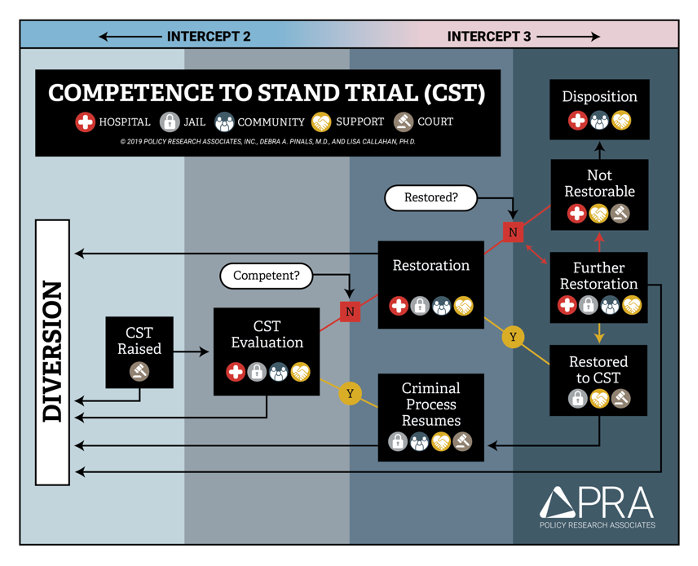Courts can raise concerns around a person’s competence to stand trial (CST) during the pretrial process. They do this when individuals exhibit signs of conditions that can impair their ability to understand the charges brought against them and assist their attorney in preparing their defense. The signs and symptoms of such conditions vary. The conditions can include serious mental illness, intellectual and developmental disabilities, or disorders affecting neurocognition and behavior. When these concerns arise, the court can order a competence examination requiring forensic evaluation and further systems involvement. Often it is a lengthy and expensive process.
Individuals that may require CST evaluation are rarely considered for diversion, though they tend to be ideal candidates for community-based services. Instead, people can become detainees for long periods in jails or state psychiatric hospitals while waiting for an evaluation. This can have harmful results. Potential negative outcomes include reentry into the forensic or criminal legal system—a misuse of resources. This misallocation has overburdened the mental health system in many places and has been the subject of class-action lawsuits brought against states.
Our Solution
At every point in the CST process, there is a gatekeeper who has the ability to divert an individual to community-based treatment. But the different parts of the CST system are often poorly connected. This prevents gatekeepers from seeing the bigger picture and coordinating with one another. The Competence to Stand Trial Mapping catalyzes these needed connections. It helps communities identify decision-makers, critical partners, and programs within the CST/competence restoration (CR) system. Systems Mapping and Training Center facilitators work with communities to identify these people and resources and incorporate them into a map. This map helps working partners see duplication and gaps.
Working together, Systems Mapping and Training Center facilitators can help communities improve their CST processes. The mapping process aims to implement solutions to decrease waitlists and shorten a defendant’s length of stay in a hospital or jail setting. Strategies could include, but are not limited to the following:
- Establishing bail considerations to allow for release with support
- Ensuring rapid access to brief clinical or forensic evaluations
- Installing screening protocols to determine the needed level of care
- Training forensic evaluators on potential community-based services to identify alternatives to traditional inpatient restoration
- Creating positions for forensic navigators who can provide support to people in the competence system and share information with collaborators on potential diversion programs
Our Model
The Competence to Stand Trial (CST) flowchart focuses on Intercepts 2 (Initial Detention/Initial Court Hearings) and 3 (Jails/Courts) of the Sequential Intercept Model. These intercepts are key decision points where competence is often first raised—after arraignment and before case adjudication and sentencing. During this time, criminal legal and behavioral health professionals have the opportunity to consider and create diversion opportunities. These could include bail considerations, rapid access to evaluations, linkage to trauma programs, and specialty court dockets, among others (Pinals & Callahan, 2020).
In addition to providing diversion opportunities for those for whom CST is raised, Intercepts 2 and 3 offer a broad range of possibilities for those who have been ruled incompetent to stand trial (IST) with the potential for restoration. They even present opportunities to divert those found not restorable.
The Competence to Stand Trial flowchart outlines a series of common decision points within the CST process. Some examples of these events are evaluation, restoration, and disposition. Each decision point highlights possible outcomes and places where individuals could be referred. These include hospitals, jails, community-based treatment services, supportive services, and courts.
Participants
The participants involved in the Competence to Stand Trial Mapping include the following:
- Advocates
- Behavioral health providers
- Community-based services
- Courtroom and legal professionals, specifically judges, district attorneys, and defense counsel
- Housing authorities
- Families of individuals for whom CST has been raised
- Forensic evaluators
- Healthcare providers
- Jail staff
- Law enforcement
- People with lived experience
Case Studies
Over the past 10 years, Policy Research has collaborated with states to reimagine their CST/CR systems. Many different vehicles have enabled this effort. Policy Research has worked with different localities through SAMHSA’s GAINS Center’s Learning Collaboratives, the Trueblood settlement in Washington State, and other fee-for-service activities.
Highlights From the Learning Collaboratives
- California implemented a forensic mental health diversion program in 24 counties.
- The District of Columbia worked with subject-matter experts to improve the specificity of CR statutes. They also found ways to work with the court system and balance limited resources with protecting defendants’ rights.
- Florida established a statewide review of competence assessment services. They also developed recommendations for improving services.
- Nebraska planned and designed an outpatient restoration program. The state also passed laws to allow for community-based CR.
- North Carolina planned to establish community-based CR in one pilot community. The state outlined steps to develop the CR process for the pilot. They identified community-based supports the pilot would depend on. And they learned about an alternative model for forensic evaluations through state-to-state sharing.
- Oregon developed a strategic plan to build regional forensic centers.
- Utah expanded crisis services to improve community-based restoration and criminal legal system diversion. It developed a certification plan and training program for forensic evaluators. This program will improve the quality of competence evaluations. The state also developed a strategic plan to centralize the state’s forensic evaluation system and a court-ordered CR template.
Highlights From the 2023 and 2024 CST/CR Policy Academies
In 2023 and 2024, Policy Research hosted Competence to Stand Trial/Competence Restoration Policy Academies to advance the work of state teams engaged in the CST/CR Learning Collaborative. The Policy Academies focused on strengthening relationships between state and local leadership, identifying possible improvements to the competence system, developing best practices to share nationally, and creating 3–5-year strategic plans for each team to use in goal implementation. During and after the Policy Academies, Policy Research provided technical assistance to each team, helping them to advance the following initiatives:
- Alabama (2023): Focused on workforce development, data management, and the creation of standard form orders for outpatient restoration for judicial use.
- Hawai’i (2024): Interested in implementing and expanding rapid diversion programs throughout the state.
- District of Columbia (2023): Focused on identifying appropriate screening instruments to maximize early identification of individuals who are eligible for diversion and need treatment.
- Missouri (2024): Explored methods to fund competence restoration services provided by a federally qualified health center (FQHC) at the jail and legislative strategies for accessing additional state funding.
- Montana (2024): Focused on increasing state funding, building community-based services, and sustaining long-term diversion and competence restoration programs.
- New Mexico (2023): Prioritized developing and establishing a competence docket within the court system.
- North Carolina (2023): Interested in evaluating the state’s competence restoration pilot.
- Ohio (2024): Prioritized medication, diversion, and funding efforts.
- Oregon (2024): Focused on expanding the state’s diversion program, organizing state operations to improve communications efficiency, and increasing funding for individuals with mental illness after arrest.
- Texas (2023): Interested in applying the criminogenic risk and the risk, needs, and responsivity model to outpatient and jail-based restoration programs.
- Virginia (2024): Focused on increasing diversion and data management opportunities to reduce redundancies.
- Wisconsin (2024): Interested in expanding mobile competence restoration programs and competence evaluations.
Highlights From the Trueblood Settlement
In 2019, Policy Research provided intensive technical assistance to the Washington State Trueblood Court Monitor’s Office, the Trueblood Workgroup, and community partners. Together they developed a collaborative structure to guide the strategic planning to address court compliance priorities in Washington State’s competence to stand trial process. Policy Research produced a set of nine recommendations for communities looking to enhance their competence evaluation, restoration, and jail diversion and reentry processes.
Follow-Up Assistance
Follow-up technical help is not always needed after your cross-systems mapping event. However, some jurisdictions find additional assistance useful. If your community wants more support, the Systems Mapping and Training Center is here. The Center can host follow-up meetings, including facilitated strategic planning sessions, give guidance and resources, or connect you with topic experts. These follow-up opportunities are offered on a fee-for-service basis if the need comes up.
References
Pinals, D. A., & Callahan, L. (2020). Evaluation and restoration of competence to stand trial: Intercepting the forensic system using the Sequential Intercept Model. Psychiatric Services, 71(7), 698–705. https://doi.org/10.1176/appi.ps.201900484




